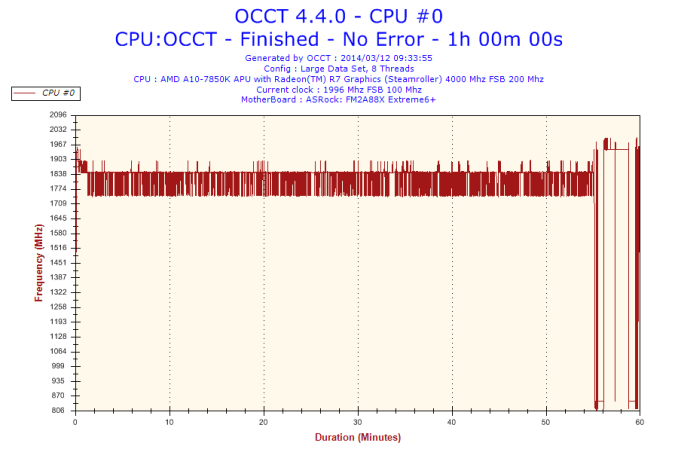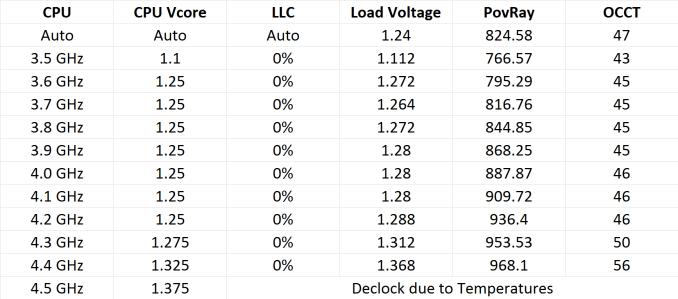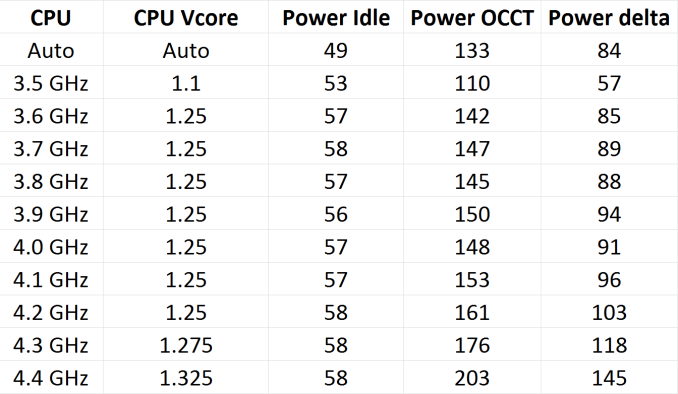ASRock FM2A88X Extreme6+ Review
by Ian Cutress on March 19, 2014 11:59 AM ESTASRock FM2A88X Extreme6+ In The Box
AMD motherboards in general do not tend to have bonus bundles and packages. The last one of note was one of the ROG motherboards, but as we alluded to earlier, manufacturers do less in terms of motherboard innovation on the AMD platform as they do with Intel. This is purely as a result of sales volume. I am sure that if any of the manufacturers wanted to, we would see a PLX 8747 chip on an AMD motherboard for four-way x8/x8/x8/x8 AMD gaming, but there is no demand. This reflects back to the veracity of motherboard box contents, such that from ASRock we have:
Driver CD
Manuals
Rear IO Shield
Four SATA Cables
Because the A88X platform does not support SLI, there is no need for an SLI bridge. Similarly, there is no USB 3.0 front panel or extra utilities – the Extreme6+ is almost a box with almost the bare essentials.
ASRock FM2A88X Extreme6+ Overclocking
Experience with ASRock FM2A88X Extreme6+
Our overclocking experience with the FM2A88X Extreme6+ is identical to what we published in the Kaveri CPU review, given that we used the same motherboard for that review and this review. The Extreme6+ has several automatic overclock options in the BIOS, and the OS does give the Operation Mode options that have been on Intel 8-series motherboards for a number of months. These are a power saving mode and a performance mode, with the power saving mode having most effect on single thread operation requiring less than a couple of seconds of CPU time.
For the manual overclock, we used the BIOS and achieved 4.4 GHz, which is a far cry from some 4.6+ GHz on air results that have been published elsewhere. Our main limitation seemed to be the VRM cooling, given that the system de-clocked the CPU when we were at 4.5 GHz.
One issue worth mentioning, given the heat generation issue mentioned at the top of the review, is how the motherboard deals with overheating. Given that our normal overclocking tests are done for 5 minutes, we tested the system at stock for an hour with OCCT monitoring the CPU frequency:
While OCCT has an issue reading the base frequency, we see jumps from 3700 MHz (1850 on the graph) to 3500 MHz (1750 on the graph). Given that this CPU is designed to go between 3700 MHz and 4000 MHz depending on loading, this shows that even with an average CPU cooler, hard CPU work can cause the CPU to decrease in frequency with sustained CPU load. Users who are thinking of overclocking Kaveri should have some good cooling in place.
Methodology:
Our standard overclocking methodology is as follows. We select the automatic overclock options and test for stability with PovRay and OCCT to simulate high-end workloads. These stability tests aim to catch any immediate causes for memory or CPU errors.
For manual overclocks, based on the information gathered from previous testing, starts off at a nominal voltage and CPU multiplier, and the multiplier is increased until the stability tests are failed. The CPU voltage is increased gradually until the stability tests are passed, and the process repeated until the motherboard reduces the multiplier automatically (due to safety protocol) or the CPU temperature reaches a stupidly high level (100ºC+). Our test bed is not in a case, which should push overclocks higher with fresher (cooler) air.
Manual Overclock:
Our results were as follows.
This gave the following power results while using the IGP:














44 Comments
View All Comments
fteoath64 - Friday, March 21, 2014 - link
AMD/ATI needs to be very aggressive in lowering the power demands of their gpu. What NV has done in Maxwell should tell them a very important thing. Lowering the power demands means, one can cram more cores into the die, hence it will boost performance. There is so much one can cram into a specific node-technology but the power demands meaning heat dissipation is going to be a real issue that is hard to solve.With the latest R9 series running at such high heat and high power demands, it is going to impossible to cram even half that performance into an APU without resorting to water cooling so the challenge is huge for AMD to tackle. I hope they can make headway into power optimization so that we can get more serious APU chips with powerful gpus for once and help move the industry along.
Ammohunt - Thursday, March 20, 2014 - link
cpu performance is one thing getting a stable glitch free windows system has always been the true challenge. I had never seen a Win7 BSOD until i ran an FX-6100 AMD Build which i promptly replaced with an intel rig. As a server it runs linux like a champ though.Demiurge - Friday, March 21, 2014 - link
I have multiple laptops, all Intel based, at work that BSOD Win7. It isn't the CPU, it's the drivers. I know because mine doesn't crash anymore after updating the drivers. I'm pretty sure it isn't the CPU that was the weak point of failure in most problems because the CPU is one of the few things that gets tested and validated the most. Not saying it can't happen, but it is far more likely you or the device manufacturers screwed up. Trust me, I own a Creative X-Fi =)... sometimes I don't get sound on reboot. I know the hardware's good there too.MrBungle123 - Friday, March 21, 2014 - link
I've noticed instability with AMD rigs before and discovered that the issue was that the stock voltage was too low. AMD is always trying to compete from a process node behind so I think they drive the Vcore as low as possible to try and bring down their TDP numbers and as a consequence bring the CPUs to the edge of instability.0ldman79 - Saturday, March 29, 2014 - link
Odd.I've found that most of my AMD chips can work fine with a little less voltage at stock speeds.
Of course they don't stay that way, the tech in me overclocks them and gets Cool'n'Quiet working so they idle nice and cool then ramp up when needed.
Demiurge - Friday, March 21, 2014 - link
Not sure why...I see something a little different...Tomb Raider is probably very heavily AMD CPU (just assuming relative to the other benchmark performance) optimized because the $200 APU + GTX 770 is actually outperforming (ever so slightly) the $1000 and $320 I7... In the F1 game the exact opposite is happening ~84fps vs ~129fps... from what I see in the other games, it looks like about a -15% typical difference toward the APU just by looking at a high level. That's not bad considering the price/performance ratio.
The numbers (to me) aren't important as a CPU comparison for the vague remarks I made about suspected optimization, but it does matter if you are comparing the game performance in order to make a decision about which CPU to buy if I play a particular set of games.
PUGSRULE! - Monday, August 10, 2015 - link
As of today 8-10-15 an Intel i7-4960X costs $1,100 versus an AMD A10-7850k that goes for $130. If you have an unlimited budget, yeah go for the Intel. But dollarwise, you cannot do better with the AMD. It's like comparing a Hennessey Venom GT to a Mustang.TETRONG - Wednesday, March 19, 2014 - link
Hmm, I agree. It's confusing why they keep reviewing and devoting so much time to something that hasn't been viable for a long time. Anyone can compare performance/price and conclude that there is no good AMD buy relative to Intels Core/Xeon lineup. It doesn't sound so bad until you factor in electricity which completely negates anything AMD might otherwise have going for them. Whatever you would save with the cheaper chip would get eaten up by the utilities -No thanks
tech6 - Wednesday, March 19, 2014 - link
I think they can be viable at a certain price point. Offering "good enough" performance for office and non-3D gaming computers is AMDs strength and that is where OEMs should be aiming also. Making a $100+ "Extreme" AMD board makes no performance sense at all.bobbozzo - Wednesday, March 19, 2014 - link
A mini-ITX Kaveri is attractive for HTPC builds, thanks to the excellent integrated graphics.